When choosing arrows you have the use of a spine reference chart. When choosing a stabiliser, all you normally have are photographs and prices. The aim of this article is to guide you through the stabiliser jungle and enable you to make an informed choice and purchase. As an Olympic-level coach in both recurve and compound archery, I am often asked by my pupils to explain the need for bow stabilisation. To answer this pertinent question, I use my knowledge as a composite engineer and stabiliser designer and manufacturer and give them the following information.
Any bow on its own is only 75 per cent efficient. This can rise to 90 per cent if the bow is shot with proper control by the archer using good form and a repeatable execution technique. The remaining 10 per cent, and the path to great scores, will be achieved with the use of the correct stabilisation system. The English longbow archers at Agincourt, for example, had to shoot from a great distance. The only aiming required was in judging the landing position of the arrows in the midst of the opposing army, so this type of bow only had to be accurate to a point. For the modern target archer, this will not suffice. The targets being shot at distances ranging from 18 metres indoors to 90 metres outdoors require very precise aiming and considerable skill. The skill you learn through long practice, and the sight and the stabiliser are your aiming aids. The following provides a basic introduction to the science of bow stabilisation.
Long rod: The long rod provides an essential forward point of balance to the bow. This assists the archer in achieving a stable point of aim on the target.
Short Rod: The short rod, either one or two depending on your preference, also provides balance to the bow. This is lateral balance and helps the archer to correct left and right movement of the bow and the movement about its vertical axis. This balance, if properly used, will reduce the effect of unwanted bow torque on the arrow.
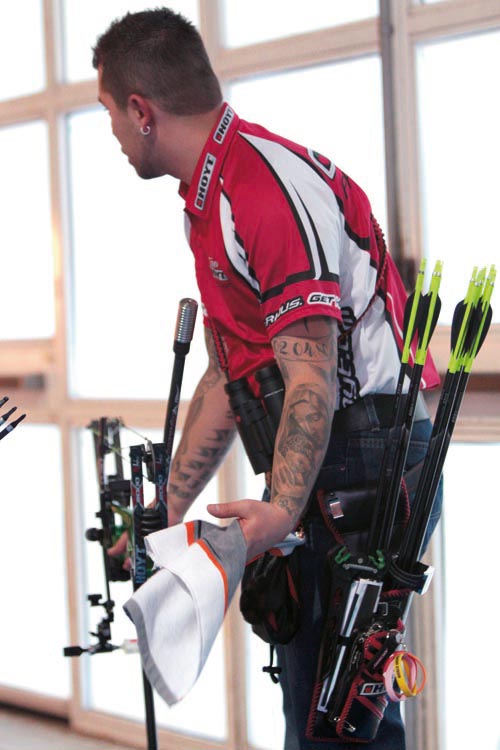 Most modern stabilisers today are made from a hollow composite, high modulus carbon-fibre tube. There are a number of parameters involved when designing for the damping of carbon fibre. Damping, in this context, is an effect that reduces the amplitude and velocity of oscillations in a carbon rod.
Most modern stabilisers today are made from a hollow composite, high modulus carbon-fibre tube. There are a number of parameters involved when designing for the damping of carbon fibre. Damping, in this context, is an effect that reduces the amplitude and velocity of oscillations in a carbon rod.
Some of these parameters can be easily controlled, such as fibre volume. Others, such as micro-cracks and misalignment, cannot. As a designer, I have conducted extensive research into these parameters. Using already established expressions, such as those propounded by Adams and Bacon, for damping at any angle, and reviewing the results of the Schultz and Tsai experiments on transverse vibrations of a cantilever beam in flexure (a stabiliser is a cantilevered beam, in that it is fixed using a single support), I constructed many prototype rods. I found that the following works best: The basic carbon rod is overlaid with a woven carbon pre-preg (already impregnated) resin matrix material. It is vital for optimum vibration absorption that the resin content is measured carefully. The pre-preg is overlaid at an angle or angles. To best achieve this, I lay my pre-preg to the rod at the following angles 45deg > 90deg > 22.5deg > 0deg.
Consequently the effective damping of the rod comes primarily from the matrix interface, the angle at which it is applied, and very little from the fibre itself. The long rod goes into the handle section of the bow, giving a permanent connection between the handle and the v-bar and acting as a shock absorber, and it can be used on both recurve and compound bows. The angled carbon stabilisers, both short and long, are designed specifically to absorb shockwave energy, which is transferred to the bow when the arrow is released. Target bows do not shoot well without any stabilising influence. In modern target shooting, a good archer will be able to card scores for three dozen arrows in the following ranges; 90m (330+ men), 70m (345+ men and women), 50m (350+) and 30m (355+), but will not be able to shoot this type of performance without good stabilisation that works. If the long rod vibrates when you are at full draw, it is simply amplifying your muscle tremors. The matrix carbon components must work to absorb the shock of the bow when the arrow is released, and the long rod must hold on the aim without tremors.
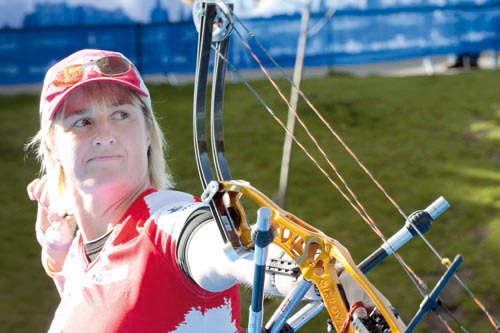 A stabiliser should not be viewed as a magic wand that will automatically ensure that your shots are guided towards the centre of the target each time. The successful coupling of the bow and stabiliser ultimately depends on the archer themselves. In order to shoot successfully with a stabiliser, it is important to have some idea of how the human body works to shoot an arrow. When looking for a coach or a teacher, find one who has a good knowledge of biomechanics and who can help your shots improve by teaching the adoption of a proper archery form, which is the skill of shooting a bow. If someone’s archery form is poor, the addition of a stabiliser will not help their accuracy. The biomechanics of archery are quite technical and outside the scope of this article, but it is important to be aware that, in order for a shot to be successful, the release must be relaxed and in line with the bow hand and should come back from the anchor straight, not sideways or at a downward angle. It is also important to note that it is virtually impossible to hold the bow completely steady. Breathing, heartbeat and muscle tension all contribute to bow movement. Therefore the stabiliser plays a big part in the aiming, holding, expansion and the release of a shot. If an archer draws a bow using their biceps and triceps, the arm will be under a great amount of muscular tension, making it difficult to hold a steady bow.
A stabiliser should not be viewed as a magic wand that will automatically ensure that your shots are guided towards the centre of the target each time. The successful coupling of the bow and stabiliser ultimately depends on the archer themselves. In order to shoot successfully with a stabiliser, it is important to have some idea of how the human body works to shoot an arrow. When looking for a coach or a teacher, find one who has a good knowledge of biomechanics and who can help your shots improve by teaching the adoption of a proper archery form, which is the skill of shooting a bow. If someone’s archery form is poor, the addition of a stabiliser will not help their accuracy. The biomechanics of archery are quite technical and outside the scope of this article, but it is important to be aware that, in order for a shot to be successful, the release must be relaxed and in line with the bow hand and should come back from the anchor straight, not sideways or at a downward angle. It is also important to note that it is virtually impossible to hold the bow completely steady. Breathing, heartbeat and muscle tension all contribute to bow movement. Therefore the stabiliser plays a big part in the aiming, holding, expansion and the release of a shot. If an archer draws a bow using their biceps and triceps, the arm will be under a great amount of muscular tension, making it difficult to hold a steady bow.
At full draw, the archer’s 20 per cent contribution is in holding the bow vertical and steady to the target. On releasing the arrow, however, the bow is going to want to move. This movement can be forward in line to the target (which is good) upwards or downwards (not so good) or the right or left (again, not good). This is where the vital remaining 10 per cent, or the stabiliser’s contribution, comes in. The stabiliser setup helps to control the movement of the bow about its various axes. You can shoot the same type of bow as your favourite archer but not necessarily the same stabiliser setup.
Having discussed how a stabiliser helps to control bow movement, it is now necessary to fine-tune the setup and performance to suit you, the archer using the bow. Long rods come in different lengths, usually 28”, 30”, 32”, 34”, as do short rods, usually 10”, 12”, 15”. Depending on the bow and you, some experimentation is vital to find the right length. Some additional weighting might be required to further fine-tune the stabiliser. Weights generally are sold as single units or stacked together. Most good stabiliser manufacturers provide a 5/16th thread bar to attach weights, so adding and subtracting weight is not a problem.
Too much weight makes the whole bow setup too difficult to raise, hold and aim. American bowhunters often use a very short (six- to eight-inch) front rod, which, apart from the challenge of using a very long rod in the woods, means they can put a lot of weight on the end of it, to be accurate with a short-axle bow at short distances (30-40 yards).
Consequently, a small amount of weight on the end of a long rod will still leave the bow easy to lift and hold and be very accurate at longer distances. Most archers seem to prefer more weight on the side rods (compound shooters often use only one side rod, recurve shooters two). Experiment in attaching the short rods to the bow. A very solid and adjustable v-bar is required. This allows the archer to experiment with offsetting them at various angles, straight out at 90 degrees to the long rod, angled downwards, or straight back at close to 90 degrees to the archer. The v-bar must be solid, or variations to the set angle or accidental movement may occur after a shot.
The on-shot noise vibration or twang of a stabiliser is something that can sometimes annoy the archer. This can be taken care of the actual design of the rod, the integral chamber size, and the overlay of the woven matrix resin material. A rubber vibration- absorption device (Simms or Doinker make very good ones) fitted to the end of the long and short rods above the weights will also help. Some people say these ruin the stabilisation effect, but this is nonsense and I find they also look great. So what should you look for when buying a stabiliser set up?
The first things to do are:
- Check the pedigree of the manufacturer – do they really know how to make a good stabiliser?
- Look for well-machined bushings and a solid fit to the bow
- Check the balance of the rods
- When first attached to the bow, it should hold well on aim, not be too heavy and dramatically improve bow hold with the addition of weight. These are known as the holding characteristics.
- Experiment to find the one that gives you the best groups
- Remember that, while good looks don’t hurt, performance is paramount
Hopefully you can now make an informed purchase of the best stabiliser setup for you and your bow. Good shooting.


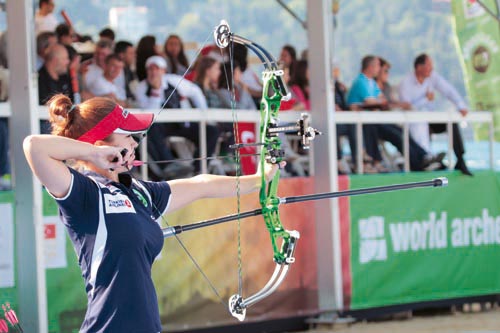
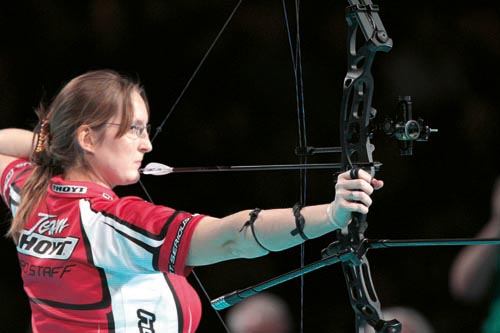
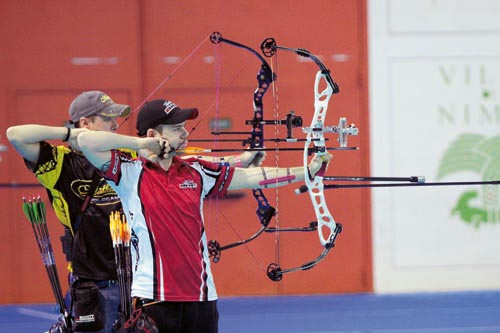
Hey I am so grateful I found your site, I really found you by mistake, while I was looking on Yahoo for something else, Anyways I am here now and would just like to say cheers for a tremendous post and a all round exciting blog (I also love the theme/design), I don’t have time to go through it all at the moment but I have book-marked it and also added in your RSS feeds, so when I have time I will be back to read a great deal more, Please do keep up the superb job.
When I originally left a comment I appear to have clicked on the -Notify me when new comments are added- checkbox and from now on every time a comment is
added I receive four emails with the same comment.
There has to be a means you are able to remove me from that service?
Thank you!
Also visit my page :: advance auto coupon code (Finley)
Regards! Useful information.
Great post. I will be dealing with a few of these issues as well..
MASTER….
fantastic submit, very informative. I’m wondering why the opposite
experts of this sector don’t realize this. You should continue
your writing. I am confident, you have a huge readers’
base already!
http://www.clearcompassmedia.com
Very nice article, exactly what I needed.
This is nicely said! .
Just what I was after. Thank you
Useful information, thank you. I followed most of until the final bullet points where it states “hold wee on aim, … and dramatically improve ira hold”. Are these typos or some technical terms?
I’ve also heard that a good starting point for stabilisation is that hanging the bow with a plumb line from the top of the bow (set up for shooting, so with sight, etc.) should pass through the arrow rest. The long-rod’s forward and side-rod’s rear weights adjust the pitch (forward-backward rotation) and the side-rod angle the roll (left-right tilt). This should provide a neutral response at release.
A great bit of background. I currently shoot a 68″ Recurve, can you provide or aim me in the right direction for any guidance about the actual setup. In that I’m referring to correct pivot points to use when testing for balance please?
I found this useful. I also found an article by Steve Ellison entitled “Controlling Bow Behaviour with Stabilisers” very useful in explaining some of the basic physics.
Thanks
The first you have to distinguish the time in in witch stabilisers have in work in the time before the release (ca 3 to 5s) the innerballistic shot time, (10 to 15ms) and the time after the Arrow leave the string. (ca 2s) It is is not very effective to talk over good or bad vibrations without that Differentiation. For Example, a very stiff Stabilisation with a high area moment of Inertia (MOA) will downsize failures in the Location of the pressure of the bow hand, because a Bow with a High (MOA) will rotate clearly slower than one with a
very small MOA. This ist valid for each axis of rotation.
This High MOA will cause in the time before release in some case a great movement of the sight an will so make the aiming process more difficult.
You will find two articles about that on my website.
Chr. Nentwig
The reference to ….. Steve Ellison entitled “Controlling Bow Behaviour with Stabilisers” is extremely useful for understanding this subject, and actually better for that than this blog.